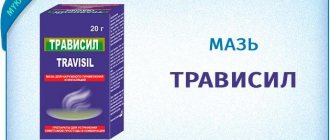What does it consist of and how does it work?
The component composition of the drug is presented:
- XIAMETER ® AFE-1510 Antifoam Emulsion;
- benzalkonium chloride;
- glycerin;
- liquid dextrose;
- indigo carmine, stearic acid;
- menthol;
- milk sugar;
- mint, eucalyptus essential oil;
- polyvinylpyrrolidone;
- sucrose;
- thymol;
- quinoline yellow dye.
The active ingredients of Septolete are used:
- to destroy bacterial infections;
- suppression of inflammation;
- reducing pain;
- relief from discomfort during swallowing;
- easier breathing.
The medicine reduces coughing and has a pleasant taste.
For whom it is intended and for whom it is prohibited
The medication is recommended for the treatment of infectious and inflammatory processes in the oropharynx. Tablets help fight:
- with pharyngitis;
- tonsillitis;
- laryngitis;
- inflammation of the oral mucosa.
Septolete is contraindicated in patients with individual intolerance to its component composition and in children under 4 years of age. Children under 6 years of age must undergo manipulations under parental supervision.
Septolete Total tbl d/rassas N16 eucalyptus
Septolete total, lozenges for children over 12 years of age,
instructions for use
Trade name of the drug:
Septolete total
International nonproprietary name:
benzydamine + cetylpyridinium chloride
Dosage form:
lozenges
Composition:
1 lozenge contains: active substance: benzydamine hydrochloride 3,000 mg Cetylpyridinium chloride monohydrate 1,050 mg, equivalent to cetylpyridinium chloride 1,000 mg excipients: eucalyptus ta rod-shaped leaves oil 1,200 mg, levomenthol 5,000 mg, sucralose (E955) 3,500 mg, citric acid (E330) 15,000 mg, isomalt (type M) (E953) 2471.285 mg, brilliant blue dye (E133) 0.015 mg
Description:
Round tablets with beveled edges with rough surface from light blue to light blue.
A white coating, uneven coloring, the presence of air bubbles in the caramel mass and slight unevenness of the edges are allowed. Pharmacotherapeutic group:
non-steroidal anti-inflammatory drug + antiseptic
Pharmacological properties
Pharmacodynamics Benzydamine is a non-steroidal anti-inflammatory drug with anti-inflammatory, analgesic and local anesthetic effects.
Cetylpyridinium chloride is an antiseptic from the group of quaternary ammonium compounds, has antimicrobial, antifungal, and virucidal effects.
Pharmacokinetics Absorption Of the two active ingredients - cetylpyridinium chloride and benzydamine - only benzydamine is absorbed through the mucous membranes.
Therefore, cetylpyridinium chloride does not interact pharmacokinetically with benzydamine at the systemic level.
The absorption of benzydamine through the mucous membranes of the oral cavity and pharynx was shown by detecting the active substance in the blood serum, the amount of which, however, was insufficient to provide a systemic effect. Absorption of benzydamine is greater with dosage forms that dissolve in the mouth compared to topical dosage forms (eg, oral spray). Distribution The volume of distribution of all dosage forms is the same. Excretion Excretion occurs mainly by the kidneys, mostly in the form of inactive metabolites. The half-life and total clearance are similar for all dosage forms. Indications for use
Symptomatic treatment of pain syndrome of inflammatory diseases of the oral cavity and ENT organs (of various etiologies).
Contraindications
Hypersensitivity to the active substances or to any auxiliary components of the drug.
Children's age up to 12 years. With caution: Hypersensitivity to acetylsalicylic acid or other non-steroidal anti-inflammatory drugs, bronchial asthma (including
a history).
Use during pregnancy and breastfeeding
The use of Septolete total during pregnancy and breastfeeding is possible only after consultation with your doctor, if the expected benefit to the mother outweighs the potential risk to the fetus and child.
Directions for use and dosage:
The tablets should be dissolved slowly in the mouth every 3-6 hours.
Adults, elderly patients and children over 12 years of age The recommended dose is 3-4 tablets per day. Do not exceed the indicated dose. To achieve optimal results, Septolete Total should not be used immediately before or after brushing your teeth. The drug Septolete total should not be used simultaneously with other drugs from the group of antiseptics. Septolete total should not be used for more than 7 days. Side effect
Classification of the frequency of side effects recommended by the World Health Organization (WHO): very often ]1/10 often from ]1/100 to [1/10 infrequently from ]1/1000 to [1/100 rarely from ]1/10000 up to [1/1000 very rare [1/10000 frequency unknown cannot be estimated from available data.
Immune system disorders: rarely: hypersensitivity reactions; frequency unknown: anaphylactic reactions. Nervous system disorders: frequency unknown: numbness of the oral mucosa. Disorders of the respiratory system, chest and mediastinal organs: rarely: bronchospasm. Gastrointestinal tract disorders: very rare: irritation of the oral mucosa, burning sensation in the cavity. Skin and subcutaneous tissue disorders: rare: urticaria, photosensitivity; frequency unknown: angioedema, skin itching. Overdose
Symptoms: Toxic manifestations of benzydamine overdose include: agitation, convulsions, increased sweating, ataxia, chills and vomiting.
Signs and symptoms of intoxication when ingesting significant quantities of cetylpyridinium chloride: nausea, vomiting, edema, cyanosis, asphyxia with subsequent paralysis of the respiratory muscles, depression of the central nervous system, arterial hypotension and coma. The lethal dose for humans is about 1-3 g. Treatment: due to the lack of a specific antidote, treatment of acute benzydamine intoxication is symptomatic. Treatment of cetylpyridinium chloride overdose is also symptomatic. In case of overdose, consult a doctor. Interaction with other drugs
Not studied.
Simultaneous use with other drugs from the group of antiseptics should be avoided. Special instructions
The drug Septolete total should not be used for more than 7 days.
If there are no noticeable signs of improvement, you should consult a doctor. When using Septolete total, hypersensitivity reactions may develop. In this case, it is recommended to stop treatment and consult a doctor to prescribe appropriate therapy. If there is an ulcerative lesion of the mucous membrane of the oropharynx, the patient should consult a doctor if symptoms persist for more than three days. The use of Septolete total is not recommended in patients with hypersensitivity to acetylsalicylic acid or other non-steroidal anti-inflammatory drugs. The drug Septolete total should not be used simultaneously with anionic compounds (for example, present in toothpaste). Therefore, it is not recommended to use the drug immediately before or after brushing your teeth. Concomitant use with milk may reduce the antimicrobial effect of cetylpyridinium chloride, therefore Septolete total should not be used simultaneously with milk. Effect on the ability to perform potentially hazardous activities that require special attention and quick reactions (for example, driving vehicles, working with moving mechanisms)
The drug Septolete total does not affect the ability to drive vehicles and work with mechanisms.
Release form
Lozenges, 3 mg + 1 mg.
8 tablets in a blister made of a combined material of PVC/polyethylene/PVDC-aluminum foil. 1, 2, 3 or 4 blisters are placed in a cardboard pack along with instructions for use. Storage conditions
At a temperature not exceeding 25C, in the original packaging.
Keep out of the reach of children. Shelf life:
2 years.
Do not use the drug after the expiration date. Conditions of release
Dispensed without a prescription.
The appearance of the product may differ from the photographs on the website.
Information about medications posted on the site is intended for specialists and includes materials from publications from different years. The information provided on the site is general and is presented for informational purposes only, does not replace consultation with a doctor and cannot serve as a guarantee of the positive effect of the drug. Tvoyaapteka.rf warns you about possible negative consequences that may arise as a result of incorrect use of the information presented on the site and strongly recommends that you consult with a specialist before choosing a drug.
You can find detailed and up-to-date instructions for the drug on the website of the State Register of Medicines www.grls.rosminzdrav.ru.
How to use
The instructions draw attention to the fact that Septolete is intended for use in the complex treatment of infections and inflammations of the oropharynx, including stomatitis, pharyngitis, tonsillitis, gingivitis:
- children from 4 to 10 years – up to 4 tablets daily, every 3-4 hours;
- from 10 to 12 years – up to 6 units per day;
- after 12 years - up to 8 pieces every day, every 2-3 hours.
The medicine should not be used before or after meals. It should not be washed down with milk due to a decrease in the antimicrobial effect of the components. The drug is kept in the mouth until completely dissolved; after the process is completed, you should not eat or drink for 1 hour.
Septolete Total lozenges 16 pcs
Registration Certificate Holder
KRKA (Slovenia)
Dosage form
Medicine - Septolete® Total
Description
Lozenges
from light blue to blue, round, with beveled edges, with a rough surface; A white coating, uneven coloring, the presence of air bubbles in the caramel mass and slight unevenness of the edges are allowed.
1 tab.
benzydamine hydrochloride 3 mg cetylpyridinium chloride monohydrate 1.05 mg, which corresponds to the content of cetylpyridinium chloride 1 mg
Excipients
: eucalyptus leaf oil - 1.2 mg, levomenthol - 5 mg, sucralose (E955) - 3.5 mg, citric acid (E330) - 15 mg, isomalt (type M) (E953) - 2471.285 mg, brilliant blue dye (E133) - 0.015 mg.
8 pcs. - blisters (1) - cardboard packs. 8 pcs. - blisters (2) - cardboard packs. 8 pcs. - blisters (3) - cardboard packs. 8 pcs. - blisters (4) - cardboard packs.
Indications
Symptomatic treatment of pain syndrome of inflammatory diseases of the oral cavity and ENT organs (of various etiologies): gingivitis, glossitis, stomatitis (including after radiation and chemotherapy); pharyngitis, laryngitis, tonsillitis; candidiasis of the oral mucosa (as part of combination therapy); calculous inflammation of the salivary glands; after surgical interventions and injuries (tonsillectomy, jaw fractures); after treatment and tooth extraction; periodontal disease.
Contraindications for use
Children under 6 years of age;
children under 12 years of age (for spray); hypersensitivity to benzydamine or cetylpyridinium chloride. With caution
Hypersensitivity to acetylsalicylic acid or other NSAIDs; bronchial asthma (including a history), liver disease, alcoholism, traumatic brain injury, brain disease, pregnancy, breastfeeding.
pharmachologic effect
Combined drug for local use.
Benzydamine
- NSAIDs from the indazoles group. It has an anti-inflammatory and local analgesic effect, and has an antiseptic effect against a wide range of microorganisms. The mechanism of action of the drug is associated with the stabilization of cell membranes and inhibition of prostaglandin synthesis.
Benzidamine has an antibacterial and specific antimicrobial effect due to rapid penetration through the membranes of microorganisms with subsequent damage to cellular structures, disruption of metabolic processes and cell lysosomes.
Has antifungal effect against Candida albicans. Causes structural modifications of the cell wall of fungi and their metabolic chains, thus preventing their reproduction, which was the basis for the use of benzydamine for inflammatory processes in the oral cavity, including infectious etiology.
Cetylpyridinium chloride
- antiseptic, quaternary ammonium compound, belongs to cationic surfactants. It has antimicrobial activity against gram-positive and to a lesser extent gram-negative bacteria. Does not affect bacterial spores. It has variable antifungal activity and is effective against some viruses.
Drug interactions
Simultaneous use with other drugs from the group of antiseptics should be avoided.
Dosage regimen
The drug is used topically, after meals. The frequency of use depends on the age of the patient and the dosage form of the combination drug used.
Side effect
Determination of the frequency of adverse reactions: very often (≥1/10); often (from ≥1/100 to <1/10); uncommon (from ≥1/1000 to <1/100); rare (from ≥1/10,000 to <1/1000); very rare (<1/10,000); frequency unknown (cannot be estimated from available data).
From the immune system:
rarely - hypersensitivity reactions.
From the nervous system:
frequency unknown - numbness of the oral mucosa.
From the respiratory system:
rarely - bronchospasm.
From the digestive system:
very rarely - irritation of the oral mucosa, burning sensation in the mouth.
From the skin and subcutaneous tissues:
rarely - photosensitivity; frequency unknown - itchy skin.
Allergic reactions:
rarely - urticaria; frequency unknown - angioedema.
special instructions
If there is an ulcerative lesion of the mucous membrane of the oropharynx, the patient should consult a doctor if symptoms persist for more than 3 days.
Should not be used simultaneously with anionic compounds (for example, they are present in toothpaste). Therefore, it is not recommended to use immediately before or after brushing your teeth.
Use during pregnancy and breastfeeding
Restrictions during pregnancy - Contraindicated. Restrictions when breastfeeding - Contraindicated. Should not be used during pregnancy and breastfeeding.
Use in elderly patients
Restrictions for elderly patients - No restrictions. The drug is approved for use in elderly patients
Use in children
Restrictions for children - With caution.
Use is contraindicated in children under 6 years of age.
Manufacturer's instructions
The leaflet contains the following details:
- before starting treatment, you must consult with your doctor and obtain his approval for the procedure;
- tablets are not intended for patients under 4 years of age, children under 6 years of age cannot carry out procedures independently - only together with adults;
- it is forbidden to exceed the recommended dosages;
- for chronic cough, hoarseness, consultation with a therapist is necessary;
- if improvement does not occur after 72 hours, and the fever, cephalgia and vomiting remain, then the doctor should select a different course regimen;
- for diabetes mellitus, it is necessary to take into account that each unit of medication contains sucrose, sorbitol, lactose, and glucose.
Septolete is not prescribed to pregnant and lactating women due to the lack of full-fledged clinical studies proving its safety for the fetus and the maternal body.
The product does not affect the speed of reactions. During therapeutic activities, it is allowed to drive a car and work with complex moving mechanisms.
Before manipulation, you must inform your doctor about taking other medications or recently completed treatment. The annotation does not contain information about registered cases of interaction of tablets with other drugs. Citrates, salicylates, surfactants, and iodides are incompatible with benzalkonium chloride.
Septolete Total lemon and honey lozenges 3mg/1mg No. 8x2
Name
Septolete total lemon and honey.
Description
Lozenges 3mg/1mg N16.
Main active ingredient
Benzidamine + cetylpyridinium chloride.
Release form
Lozenges.
Dosage
3 mg+1 mg.
pharmachologic effect
Means for the treatment of diseases of the larynx and pharynx. Antiseptics.
Indications for use
Local treatment as part of complex therapy for infectious and inflammatory diseases of the oral cavity and pharynx (tonsillitis, pharyngitis, stomatitis, gingivitis).
Directions for use and doses
Dosage Children aged 6 to 12 years: The recommended dose is 3 tablets per day. In this age group, the drug is recommended to be used after consulting a doctor. The drug is contraindicated in children under 6 years of age. Children aged 12 years and older: The recommended dose is 3-4 tablets per day. Adults: The recommended dose is 3-4 tablets per day. Elderly patients. No dose adjustment is required. Do not exceed recommended doses. Do not take a double dose of the drug to make up for a missed dose. Directions for use The tablets should be dissolved slowly in the mouth every 3-6 hours. To achieve optimal results, do not use the drug immediately before or immediately after brushing your teeth. Course of treatment The drug should not be used for more than 7 days. If there are no noticeable signs of improvement (or if it worsens) after 3 days of treatment, you should consult your doctor.
Use during pregnancy and lactation
If you are pregnant or breastfeeding, you should consult your doctor before taking any medications. Use during pregnancy is not recommended. When prescribing a drug to a breastfeeding woman, the doctor will evaluate the advisability of stopping breastfeeding, taking into account its benefits for the child and the expected benefits of therapy for the mother.
Interaction with other drugs
Before you start taking it, you must tell your doctor that you are taking or have recently taken any medications. Simultaneous use with drugs from the antiseptic group is not recommended.
Contraindications
Hypersensitivity to the active substances or other components of the drug. The drug is contraindicated in children under 6 years of age.
Compound
1 lozenge contains. Active ingredients: 3 mg benzydamine hydrochloride and 1 mg cetylpyridinium chloride (in the form of monohydrate). Excipients: eucalyptus oil, levomenthol, sucralose (E955), anhydrous citric acid (E330), isomalt (E953), brilliant blue (E133).
Overdose
If you take doses higher than recommended, you should immediately inform your specialist.
Side effect
Like all medicines, Septolete total may in some cases cause undesirable effects. In rare cases (1 in 1000), the following are possible: - hypersensitivity reactions, - urticaria, increased sensitivity of the skin to sunlight, - bronchospasm. In very rare cases (1 in 10,000) the following are possible: - local irritation of the oral mucosa, a slight burning sensation in the mouth. In cases for which the frequency is unknown (cannot be established on the basis of available data), the following are possible: - a burning sensation or numbness (loss of sensitivity) of the oral mucosa. If any adverse reactions occur, including those not listed in this leaflet, you should stop using the drug and consult a doctor. By following the recommendations for use presented in this leaflet, you reduce the risk of adverse reactions.
Storage conditions
Store in original packaging to protect from light. Does not require special temperature storage conditions. Keep out of the reach of children.
Buy Septolete Total lemon and honey tablet for rassas. 3mg/1mg per bl. in pack No. 8x2 in the pharmacy
Price on Septolete Total lemon and honey tablet for rassas. 3mg/1mg per bl. in pack №8x2
Instructions for use for Septolete Total lemon and honey tablet for rassas. 3mg/1mg per bl. in pack №8x2
Analogs
Replacement therapy is carried out when signs of intolerance to Septolete appear. Popular analogues of tablets are presented:
- Agisept;
- Anti-Sore throat;
- Falimint;
- Grammidin;
- Faringosept;
- Strepsils;
- Hexoral Tabs;
- Tantum Verde.
The search for a suitable substitute is carried out by the local otolaryngologist. The selection of medication is based on the results of a diagnostic examination, the general condition of the body, the reasons for the development of allergic and other reactions.



